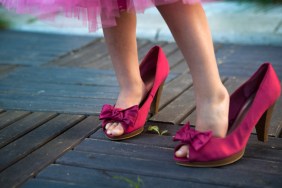Lilly wants to be a princess when she grows up.
She’s four years old and 34 pounds of sass, satin and pink glitter. I’m 32 and I own 34 pounds of flannel. She is my brilliant daughter; the walking, talking stereotype of “girly girl.” I am her mommy, frequently her prince and, occasionally, the village idiot.
I hate to admit that I never wanted a daughter until I had my own. I’m certainly not the picture of stereotypical femininity. My hair is quite short. Nail polish makes my fingers feel uncomfortably heavy. I never wanted a pony. I hate iced coffee. My cooking is shockingly horrible. And I don’t watch Dancing With the Stars. I don’t even know who the stars are. If there was a show called “Dancing with Popular Literary Science Fiction Characters,” I could probably be on board. As I child, I often felt like an outsider among my female peers.
When my wife and I decided to have children, I was concerned about the possibility of raising a girl in a world that values men over women and where women attack each other to gain attention and favor from men. I worried that I would never be able to bond with a little girl. What would we talk about? How would I dress her? Would I be able to feign interest in ponies and ballet long enough to keep her off the therapist’s couch? And seriously, how on earth would I ever learn to master the kind of witchcraft that turns long hair into braids and ponytails? What if she didn’t like me? What if I felt like an outsider with my own kid?
Suffice it to say, when our ultrasound technician gleefully squealed, “I see a hamburger, not a hotdog,” I had a mild attack of nerves.
My wife tried to reassure me: “You’ll be able to bond with our baby. She’ll be awesome, just like you!” And she was right about our baby being awesome. But, as it turns out, she’s awesome in spite of me.
Lilly came home from the hospital to a nursery decorated in neutral browns, greens and yellows. For the first two years, the amount of pink I allowed into her wardrobe was tightly regulated. Lilly had a wide variety of dinosaur, race car and building block toys. My mom bought her a pink doll which I “accidentally” stuck on the top shelf of the closet. Oops.
Not that this was all bad. At two, Lilly had learned to identify all the planets in the solar system. She knew four out of seven continents. She could imitate a Taun Taun perfectly. She was my buddy; my Lillaroo. I gave myself a huge, undeserved pat on the back. I should have given myself a kick in the ass.
Things changed slowly at first. The dinosaur jammies she used to love were suddenly only “for boys.” Despite my strong objections, pink worked its way into my sweet child’s closet and toy box. She started requesting tea parties instead of playing zoo animals. Her favorite stuffed rat—a tattered, gray thing that she had loudly, in the middle of a crowded IKEA, named Rat Bastard—was replaced by big sparkly-eyed, pink kittens and puppies all named Snuggles and Cuddles.
She stopped wanting to get her hair cut. Her hair grew much faster than my ability to fashion a functional ponytail. That first up-do I attempted will provide years of therapy fodder. She informed us that she wasn’t Lillaroo anymore; she wasn’t Lilly either. She was Twinkle, the girl baby kitten. She didn’t care that it was insipid. Or redundant. She wanted to be a princess when she grew up, she said. I was afraid—for her, for me and for the kingdom that would be ruled by Twinkle, the redundant feline.

Lilly became a statistic when she joined the throngs of little girls dressed up as Elsa for Halloween. I begged her to pick something else. Even another princess would have been better. “How about Belle? She loved books. Cleopatra? She had a cat (I mean baby kitten) I think. How about a suffragette? No, no, a suffragette isn’t broccoli.”
By the time her fourth birthday rolled around, every day was a constant battle of wills. Lilly refused to wear pants. Even in the winter. “The cold doesn’t bother me anyway,” she explained as she attempted to wrench a glittery sundress out of my hands. “Perhaps,” I replied. “But when love is an open door in January, people get frostbite. Put your freaking pants on.” She looked at me in tears and said, “Mommy, I love dresses. I love princesses. Why don’t you love what I love?”
I didn’t know what to say. Because dresses and princesses represent patriarchy and oppression? Not to her. The only dudes in our house are the cats and they don’t even have balls. Because strong women only wear pants? Clearly a lie because here was my tiny four year old clad in pink socks and Fluttershy undies standing her ground and challenging my absurd hangups. The only answer I could think of was that I’m an idiot who is missing out on having a princess for a buddy.
I still didn’t let her wear the sundress. It really was 15 below outside. But I sure as hell went out and bought her some sweater dresses—and sparkly leggings.
That evening, I helped Lilly into her pajamas, including her new “sleep tutu.” After she was dressed, she tugged her pink bunny slippers on to her feet and gave me a hug.
“Look at me, Mommy. I’ve got my tutu, my kitten jammies, my side ponytail and my fabulous pink slippers. I’m ready for anything!” And she totally is.
This article first appeared on AfterEllen.com








